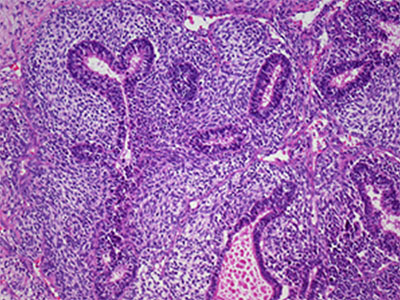
DIFFERENTIAL DIAGNOSIS
Cystic pleuropulmonary blastoma (PPB) is indistinguishable from non-neoplastic cysts in both clinical presentation and imaging features. Failure to resect and pathologically identify a cystic PPB may result in progression of this low-grade neoplasm to the highly malignant partially or completely solid forms of PPB[1].
The malformations which may result in air-filled cystic lung structures are:
For pathology trainees with varied exposure to pediatric pathology, it is important to distinguish between pleuropulmonary blastoma, a "true" blastoma of the lung, and pulmonary blastoma, a sarcomatoid carcinoma in the lungs of adults.
DISCUSSION
Pleuropulmonary blastoma (PPB) is an embryonal tumor of the lung that appears to arise during embryonic development, much like hepatoblastoma in the liver, nephroblastoma (Wilms tumor) in the kidney, neuroblastoma in the sympathetic peripheral nervous system or rhabdomyosarcoma in the muscle.
Data from the International Pleuropulmonary Blastoma Registry ( IPPBR) shows that, by imaging studies, 49% of type 1 pleuropulmonary blastomas consist of multiple cysts and a third are bilateral[2]. The most common clinical diagnosis was CCAM (50%) followed by cyst, not otherwise specified, and congenital lobar emphysema. The majority of surgical interventions are wedge resections, lobectomies and, rarely, thoracoscopic resections.
PPB is a proliferation of primitive mesenchymal cells that initially form air-filled cysts lined by benign-appearing epithelium (type 1 pleuropulmonary blastoma, cystic). Later on, the mesenchymal cells outgrow the cysts with formation of focal solid areas (type 2, solid and cystic PPB) and, finally, mainly solid mass (type 3, solid PPB).
Differential diagnosis with congenital malformations presenting as lung cysts is based on histopathologic findings. New molecular markers have recently been published that can potentially help in this differential diagnosis. A subset of PPBs (~20%) are part of an inherited cancer syndrome (there is family history of cystic nephroma of the kidney or rhabdomyosarcoma).A family-based linkage study mapped the PPB locus to 14q and identified DICER1as potentially the gene responsible for mutations leading to PPB. DICER1 immunohistochemistry of PPB tumors suggests that expression of the wild-type allele is lost in tumor-associated epithelium, but is retained in the mesenchymal cells[3]. Treatment modalities include surgery alone and addition of adjuvant chemotherapy. Prognosis is good. A small percentage of these tumors can recur (~10% in data from the IPPBR) and the recurrent tumors are types II and III PPB (higher grade). In ~10% of patients, siblings also present with cystic lung lesions and pathology analysis is consistent with PPB in the siblings as well.
PPB is a malignant neoplasm of childhood that provides us with the opportunity to study the natural progression and biology of a disease from a less aggressive form to a more aggressive phase through a sequence of morphologic changes that are correlated with age at initial observation or diagnosis, and are reflective on the clinical outcome.
The similar designation between pleuropulmonary blastoma and pulmonary blastoma is due to the latter being a misnomer. Unlike pleuropulmonary blastoma, pulmonary blastoma is a sarcomatoid carcinoma of adults, along with pleomorphic carcinoma, spindle cell carcinoma, giant cell carcinoma and carcinosarcoma. Pulmonary sarcomatoid carcinomas (PSCs) are currently defined as poorly differentiated non-small-cell carcinomas containing a component with sarcoma or sarcoma-like (spindle and/or giant cell) features[4]. The sarcomatous or sarcomatoid component of these tumors is thought to derive from carcinoma cells during the progression of carcinogenesis through the activation of an epithelial-mesenchymal transition program. The epithelial component is variable stained with antibodies binding low- and high-molecular-weight cytokeratins, epithelial membrane antigen (EMA), andcarcinoembryonic antigen(CEA), whereas the opposite holds true for the sarcomatous or sarcomatoid component, which is instead consistently immunoreactive for vimentin. Please see Fig.4 for an example of the morphology of pulmonary blastoma.

Fig. 4. Pulmonary blastoma, so-called because of its resemblance to first trimester fetal lung, is a rare, biphasic tumour that occurs at any age, with a mean of about 40 years. ( source: http://www.histopathology-india.net/pulmonary_blastoma.htm)
REFERENCES
![]() Contributed by Oana Radu, MD and Miguel Reyes-M˙gica, MD
Contributed by Oana Radu, MD and Miguel Reyes-M˙gica, MD